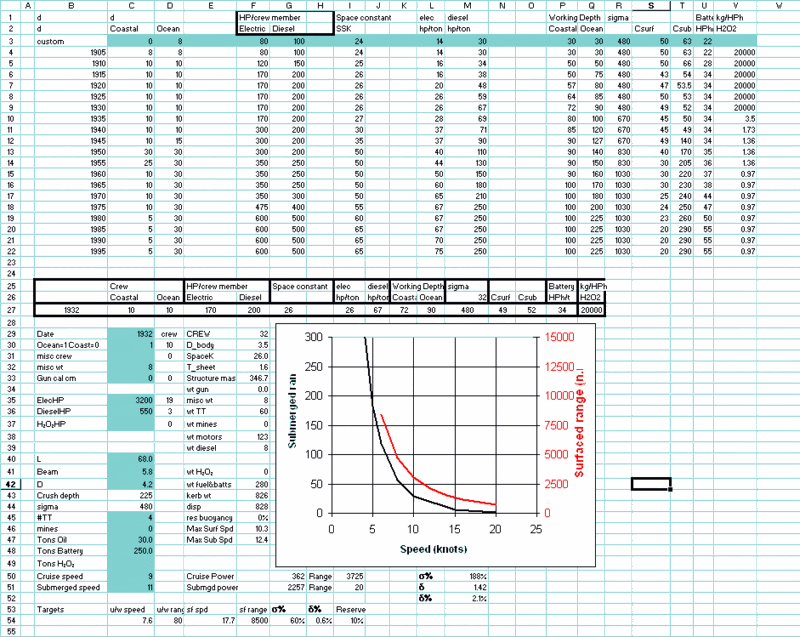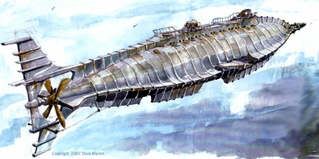Time to put oil on this fire?
The following is what I was going to post for Greek sub development but here is as good as any. I was going to post the picture as well but I don't have it handy. Many real world developments existed in the inter war period - what stopped them was money.
Greek Submarine Development
Greece started with three French built submarines pre ww1. Greece watched developments during the Dardanelles campaign where a single German submarine forced the withdraw of heavy fire support ships and RN & RAN submarines penetrated the straits and operated against Turkish shipping in the Sea of Mamara. The conclusions were that submarines were a grave threat to a seaborne invasion and only submarines can penetrate the Dardanelles. Greece has largely ignored the war on merchant tonnage as it failed but in the face of defended targets (convoy) by 1918, two out of every three attacks were on the surface at night. With the CT dictating smaller submarines coupled with Greeces need for opposing an invasion force and possible operations in and past the Dardanelles, the submarine staff have eliminated the gun from the needs of a Greek submarine. Post war development started with the aquisition of RN R-Class submarines because they were capable of high underwater speeds (the current in the Dardanelles is about 3 knots from the Black Sea) and they were on the disposal list. The four ex-R class (Hermês Class) were followed by slightly improved versions built locally, the Nemesis class running to twenty two units. The Nemesis replaced the Hermês Class's 6x18" torpedoes with 4 harder hitting 21" topredoes. The high speed submarines are short legged so a series of special transports have been built to move submarines to operational areas. These transorts have also been found to be usefull in carrying the navy's X-lighters (landing craft). Following exercises, a new transport design better suited for both submarine transport and X-lighter transport are to begin construction this year.
Aknowledging that small subs and these transports were not a perfect solution there had been growing calls to build larger submarines capable of transitting on their own power but still capable of the missions expected of the Nemesis class. After years of development the 800 ton Delphinos class subs will start construction this year.

[size=3]
S-30 Delphinos, Greek Submarine laid down 1932[/size]
Displacement:
802 t light; 819 t standard; 852 t normal; 878 t full load
Dimensions:
Length overall / water x beam x draught
196.85 ft / 196.85 ft x 21.98 ft x 13.78 ft (normal load)
60.00 m / 60.00 m x 6.70 m x 4.20 m
4 - 21.0" / 533.4 mm submerged torpedo tubes
Machinery:
Diesel Internal combustion generators plus batteries,
2 shafts, 628 shp / 469 Kw = 10.4 kts
Range 3,225nm at 9.00 kts
Bunker at max displacement = 30 tons
Electric motors, 2 shafts, 3000 shp = 12.0 kts submerged
Range 20nm at 11 kts
Battery = 250 tons
Complement:
32
Cost:
£0.860 million (estimate)
Distribution of weights at normal displacement:
Armament: 0 tons, 0.0 %
Machinery: 19 tons, 2.2 %
Hull, fittings & equipment: 569 tons, 66.8 %
Fuel, ammunition & stores: 49 tons, 5.8 %
Miscellaneous weights: 215 tons, 25.2 %
Overall survivability and seakeeping ability:
Survivability (Non-critical penetrating hits needed to sink ship):
735 lbs / 333 Kg = 6.8 x 6 " / 152 mm shells or 0.8 torpedoes
Stability (Unstable if below 1.00): 1.01
Metacentric height 0.5 ft / 0.2 m
Roll period: 12.8 seconds
Steadiness - As gun platform (Average = 50 %): 1 %
- Recoil effect (Restricted arc if above 1.00): 0.00
Seaboat quality (Average = 1.00): 0.00
Hull form characteristics:
Hull has a flush deck
Block coefficient: 0.500
Length to Beam Ratio: 8.96 : 1
'Natural speed' for length: 14.03 kts
Power going to wave formation at top speed: 34 %
Trim (Max stability = 0, Max steadiness = 100): 50
Bow angle (Positive = bow angles forward): 0.00 degrees
Stern overhang: 0.00 ft / 0.00 m
Freeboard (% = measuring location as a percentage of overall length):
- Stem: 0.10 ft / 0.03 m
- Forecastle (20 %): 0.10 ft / 0.03 m
- Mid (50 %): 0.10 ft / 0.03 m
- Quarterdeck (15 %): 0.10 ft / 0.03 m
- Stern: 0.10 ft / 0.03 m
- Average freeboard: 0.10 ft / 0.03 m
Ship tends to be wet forward
Ship space, strength and comments:
Space - Hull below water (magazines/engines, low = better): 58.7 %
- Above water (accommodation/working, high = better): 0.7 %
Waterplane Area: 2,883 Square feet or 268 Square metres
Displacement factor (Displacement / loading): 338 %
Structure weight / hull surface area: 131 lbs/sq ft or 642 Kg/sq metre
Hull strength (Relative):
- Cross-sectional: 4.48
- Longitudinal: 2.82
- Overall: 3.17
Hull space for machinery, storage, compartmentation is excellent
Ship has quick, lively roll, not a steady gun platform
Operating Depth 317ft (225ft subsim)
Quoted
Quoted
Originally posted by Red AdmiralQuoted
The one thing that I find odd is that, historically, at this period the threat to subs was seen as being ASDIC, not detection on the surface.Quoted
Fair enough but I think Italy is safe in assuming that the Greeks/Turks/Indians have eyes and would see a surfaced submarine close to land.Quoted
because Walter was trying to show the KM the advantages of the hydrogen peroxide propulsion system by breaking underwater speed records by a large margin.Quoted
that's a lot of cutting-edge ideas being packaged together over a decade earlier than historical.

